Chicken Fried Steak with the Thermapen IR
Chicken fried steak is one of the most iconic dishes of the South, and of Texas in particular. Most likely the descendant of the schnitzels that arrived with German and Austrian immigrants, its ingredients are simple and inexpensive—it was never a food for the rich. No, the hills and hollers of Texas bred this dish of cheap cuts of meat that have been tenderized, breaded, fried, and drenched with creamy milk gravy to mask their “lower” quality.Of course, you don’t have to be a Texan descended from Germanic immigrants to enjoy this delicious, homey meal.
With a little guidance from Jess Pryles, in her new book, Hardcore Carnivore, we will show you how to make a stand-out chicken fried steak that will rival the best you’ve ever had. And with the help of the Thermapen® IR, you can take the guesswork out of your steak fry. With the speed and accuracy of the Thermapen® and the added versatility of an infrared thermometer, you can monitor your whole cook with one slim tool.
Chicken fried steak basics
It’s not chicken?
If you had this question, you are not the only one. No, chicken fried steak is really a steak that has been cooked in the style of fried chicken. To cut the confusion, some restaurants call this dish “country fried steak,” which eliminates the confusion of chicken, but is pretty meaningless otherwise.
Treating a steak like fried chicken means using the “standard breading procedure” of flouring the meat, dipping it in an eggy mixture, and then dipping it into the final breading before frying. To get a shatteringly crispy crust, we mix the seasoned, final breading flour in this recipe with a little milk to make a bunch of tiny clumps. These little clumps cook up beautifully and give the steak a crispy coating like nothing you’ve ever tasted.
Steak medium rare?
If you read our blog, you know we like our steaks medium rare. But now is not the time for such finery! Chicken fried steak is customarily served at least medium well. This is not out of philistinism, but out of bare necessity. By the time the crust on the steak is golden-brown-and-delicious, the steak is usually looking at medium rare in the rear-view mirror.
“So I don’t have to worry about temperature?” Wrong. Though deep frying and pan frying come down to us through tradition, without the benefit of accurate measurement, we live better now! You want to cook your steaks in oil that is precisely 375°F (191°C), and though it’s ok if your steak gets pretty close to well done, you should look for an internal steak temperature of 145°F (63°C)—the border line between medium and medium well.
Enter the Thermapen IR. This home cooking project is great for the Thermapen IR, because it works well with the strengths of the tool. The Thermapen IR is not waterproof like the Mk4, and therefore isn’t best for outdoor cooks where rain and moisture are more likely. However, the non-contact measuring abilities of the IR are so convenient for frying! Just make sure that the adjustable emissivity is set to 0.97 for the oil in the skillet. You can check the oil temperature with the IR, and temp the inside of the steak with the super-fast probe.
With our cheap and easy ingredients and our infrared/thermocouple thermometer in hand, let’s get cooking.
Chicken Fried Steak Recipe
Based on Jess Pryles’ recipe from Hardcore Carnivore
Ingredients
For the steaks:
- 4 thin round/sirloin tip/knuckle steaks (about 2 lbs in total)
- 2 tsp, plus more kosher salt
- 10 ½ oz all-purpose flour
- 1 egg
- 9 oz milk, divided
- 2 tsp onion powder
- 2 tsp garlic powder,
- 2 tsp paprika
- 1 tsp cayenne pepper
- 1 tsp freshly ground black pepper
- 2 cups vegetable or peanut oil for pan frying
For the gravy:
- 3 Tbsp bacon fat or butter
- ¼ C all-purpose flour
- 1-2 C milk
- 1 Tbsp freshly ground black pepper
- salt to taste
Instructions
- Your butcher should be able to run the steaks through a tenderizer for you. You can usually find pre-tenderized “cube steaks” at the butcher counter, but if you have steaks that are not tenderized, pound them to ~¼” thickness with the studded side of a meat mallet.
- Season both sides of steaks with salt.
- Coat the steaks in a thin layer of flour and set aside.
- Combine the egg with 4 ½ oz of the milk in a shallow dish, whisking to combine.
- Combine the remaining flour with the onion and garlic powders, the paprika, cayenne, black pepper, and 2 tsp of salt.
- Add the remaining milk to the flour mixture a little at a time, stirring to combine. This should yield a clumpy-moist mixture, not a batter. Do not over-mix it or it will become a bad, unusable dough.
- Preheat your oven to 200°F (93 °C).
- One at a time, dip the floured steaks into the egg and milk mixture, then into the clump seasoned flour. Press on the steaks to get good adhesion from the flour mixture.
- Set steaks aside to rest.
- Heat the oil in a large cast-iron skillet. Use the Thermapen IR’s infrared thermometer to keep track of the oil’s temperature (emissivity of oil is 0.97). You want a temperature of 375°F (191°C).
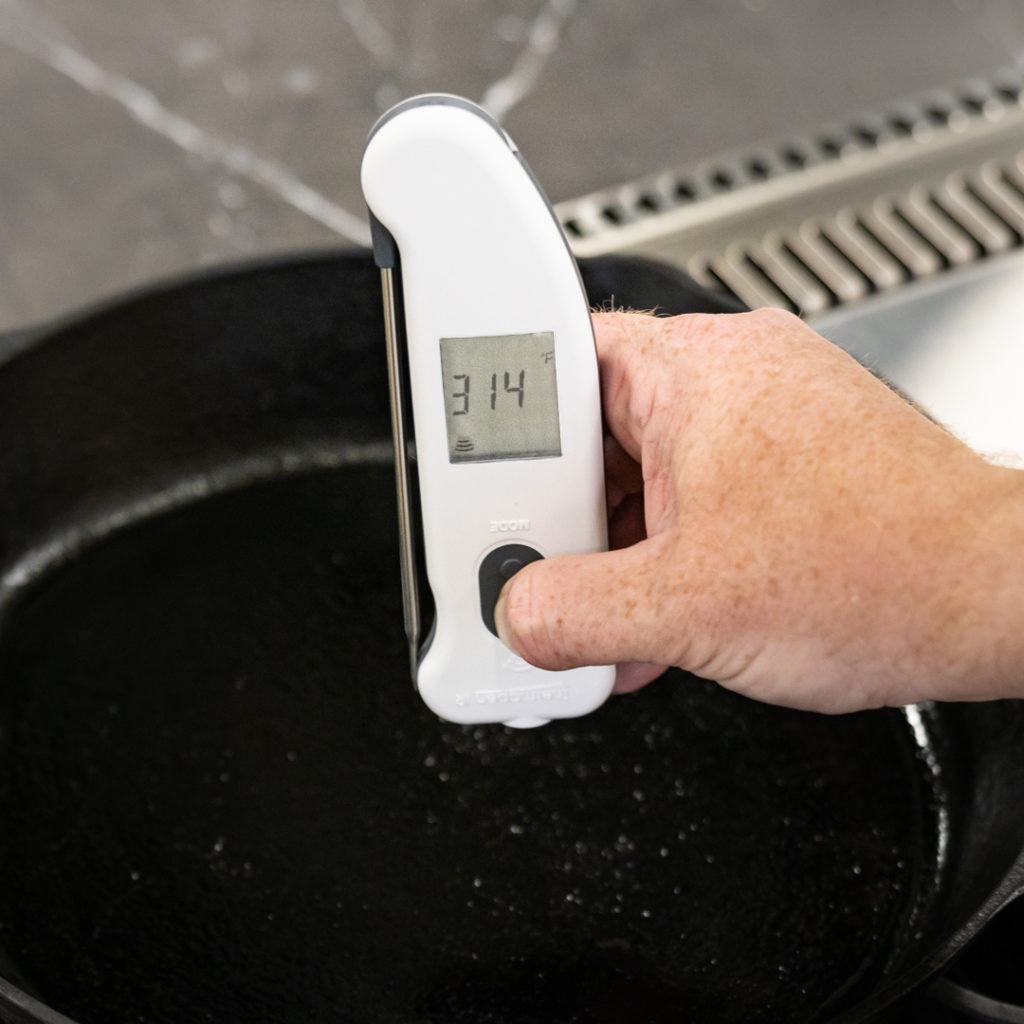
- When the oil reaches temp, add a steak to the pan, or two if they will fit.
- Cook 2-3 minutes per side, flipping when golden brown. Check the temp of the steak with the probe end of your Thermapen IR.
- When they reach 145°F (63°C), remove the steaks to a rack or plate and keep warm in the oven while you cook the other steaks and make the gravy.
- Be sure the oil comes back up to 375°F (191°C) before adding more steaks to the oil—the temperature will have dropped during the cooking. You can check this with the infrared end of your Thermapen IR.
Once the steaks are all cooked, prepare the gravy.
- Melt the fat in a skillet over medium high heat.
- When hot, add the flour to make a roux.
- Stir this mixture and let it toast just slightly.
- Add the milk, whisking as you do so, to the hot pan. Keep in mind that the gravy will thicken as it stands! So make it a little thinner in the pan than you want for your final product.
- Add pepper and salt to taste.
- Plate your steaks, ladle on the gravy, and serve! Mashed potatoes are a great side, as are some steamed or sautéed green beans.
There you have it: crispy, golden brown fried steaks that will make your mouth water. And you did it with one easy-to-use tool: the Thermapen IR. Dive in and get cooking today!
Products Used:


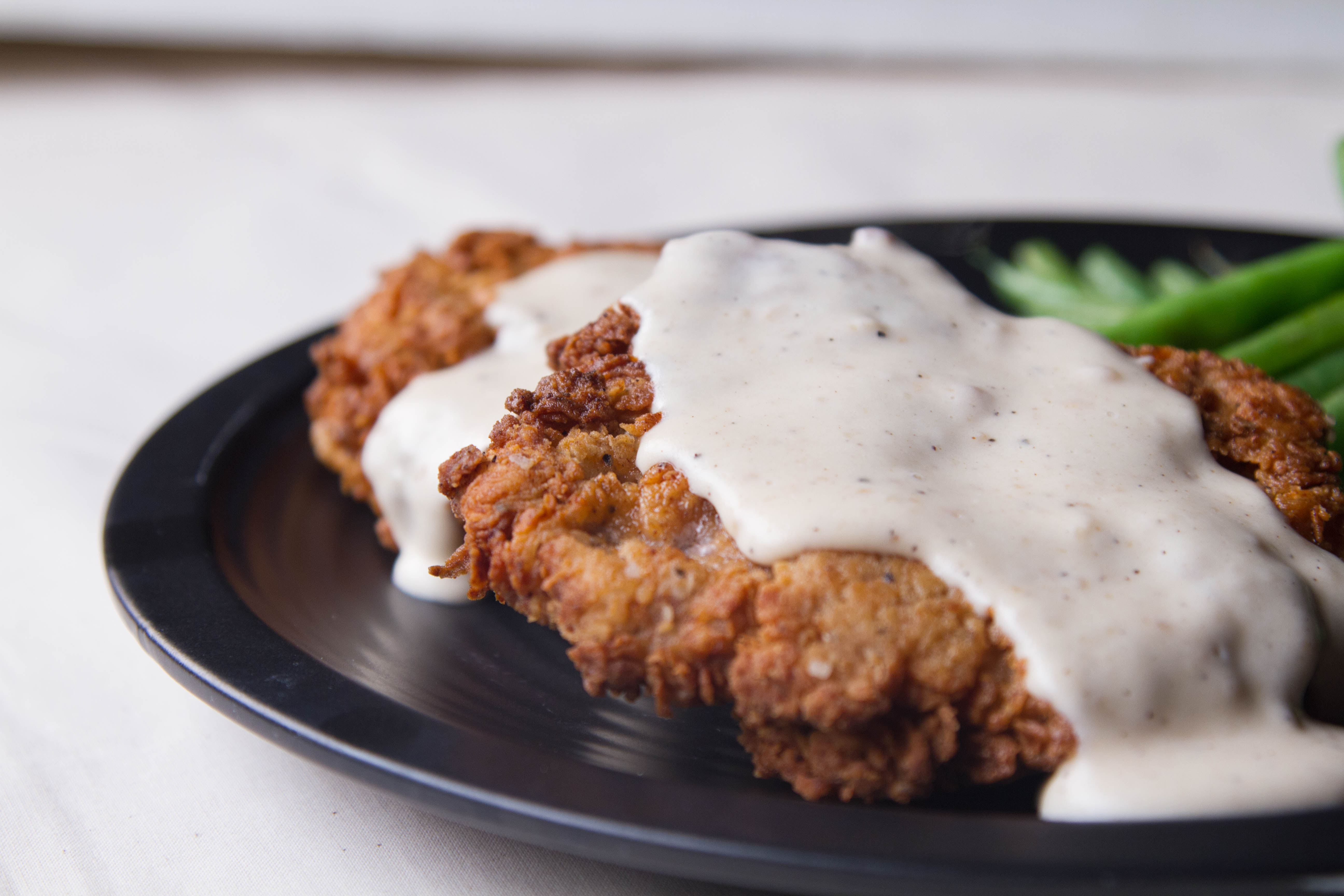
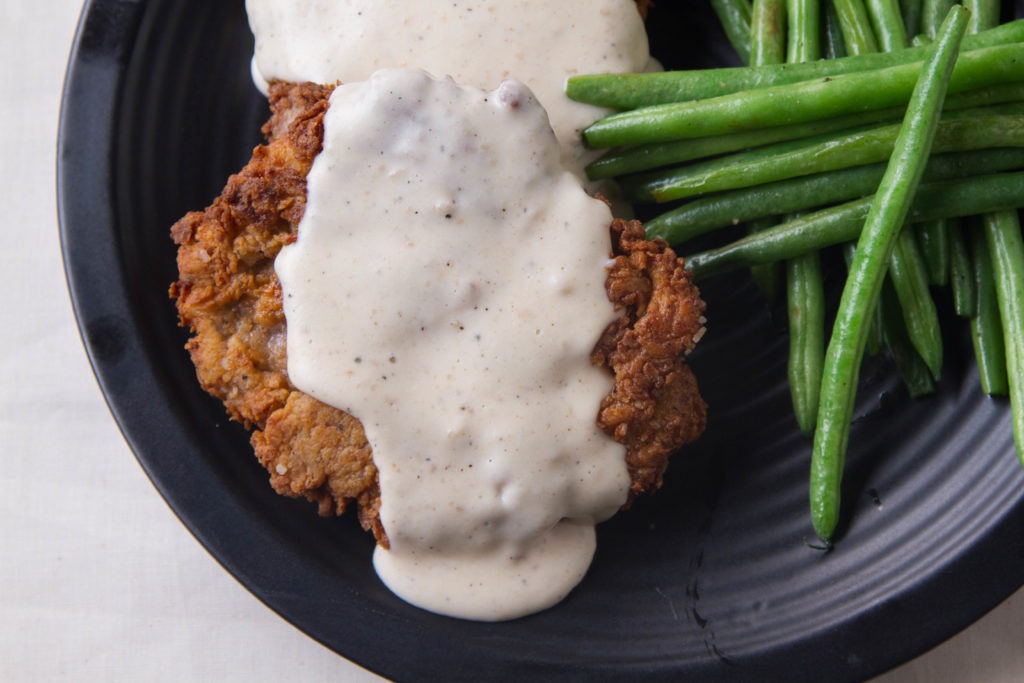
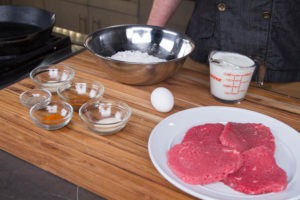





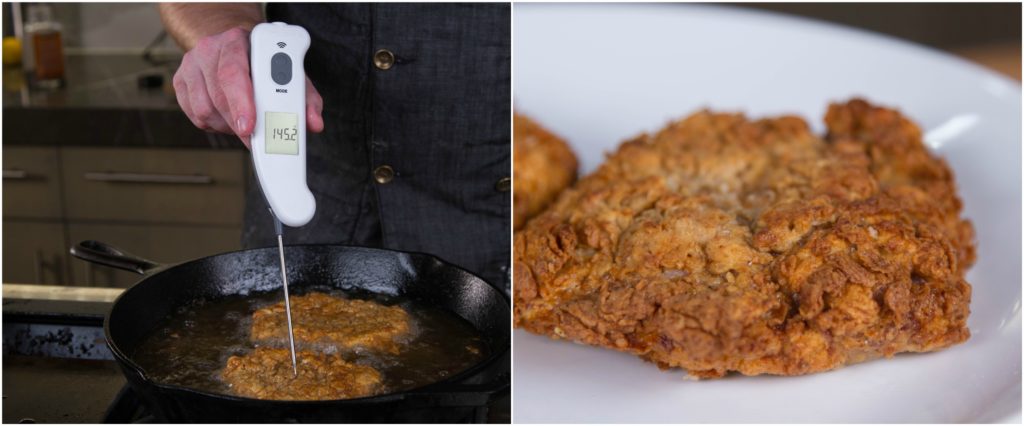

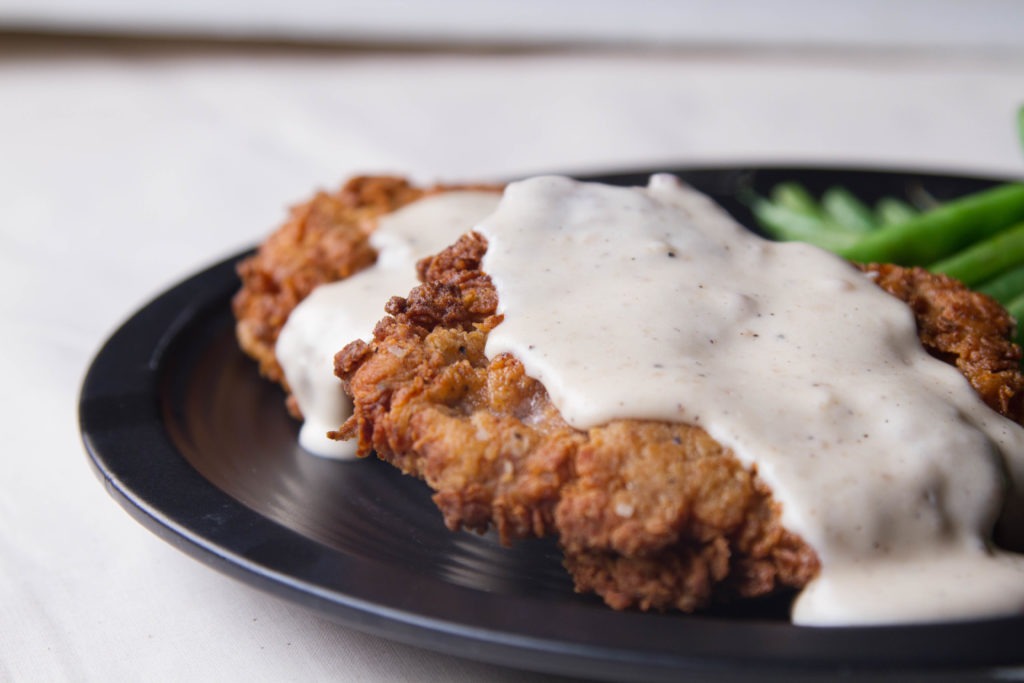
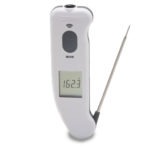
How to you think this would be using a all purpose gluten free or white rice flour?
John,
Interesting question. If you have a GF-AP flour you like, I would give it a go. The white rice flour…I have deeper doubts about. The only thing I worry about is if some of the legume proteins in some GF-AP’s might burn funnily at the temp we want. I think it should work, but that’s my only doubt about it. Give it a go and let us know how it works out!
I like mine with sunny side or over easy eggs and Grits for breakfast, or with grilled Asparagus Spears and Garden Salad for lunch or supper. Texas Toast is great for “Soppin’ ” with either.
Well, now I just want to go make more because that makes me hungry!
Yum! Thanks for the recipe!
Thanks for reading! Happy cooking!
Country fried steak – brown gravy
Chicken fried steak – white gravy
Barry,
I honestly did not know that. Thank you for clearing it up! Everybody else, is that common knowledge that I somehow missed? or did you not know it either?
I’ve seen what was called chicken-fried steak served with brown gravy, but to people who like CFS (specially Texans) they are not authentic. To confuse things more Country style steaks are usually floured nut not breaded and simmered in brown gravy..
Doc,
Interesting! I figured on the authenticity question, creamy gravy is the standard for sure. But according to this, a country style steak is more like a Salisbury steak than a CFS? Interesting…
Disaster! The breading mix was too thick and gloppy, even tho I cut back on the amount of mik. 375 degrees is too hot. Came out almost burnt after 3 minutes a side. Why a separate pan for the gravy?. Just pour off most of the oil leaving the brown bits and use the cooking pan. Could not eat. All went to the garbage!
Richard,
I’m sorry it didn’t work out for you! Using the same pan for gravy is a great idea if you have somewhere to pour off that hot fat before you start the gravy cooking. You might want to try cooking only 2 minutes/side, it might help. The flour is supposed to be clumpy and full of bits, but it does sound like yours was too wet. If your flour is high in moisture, you might need even less milk.